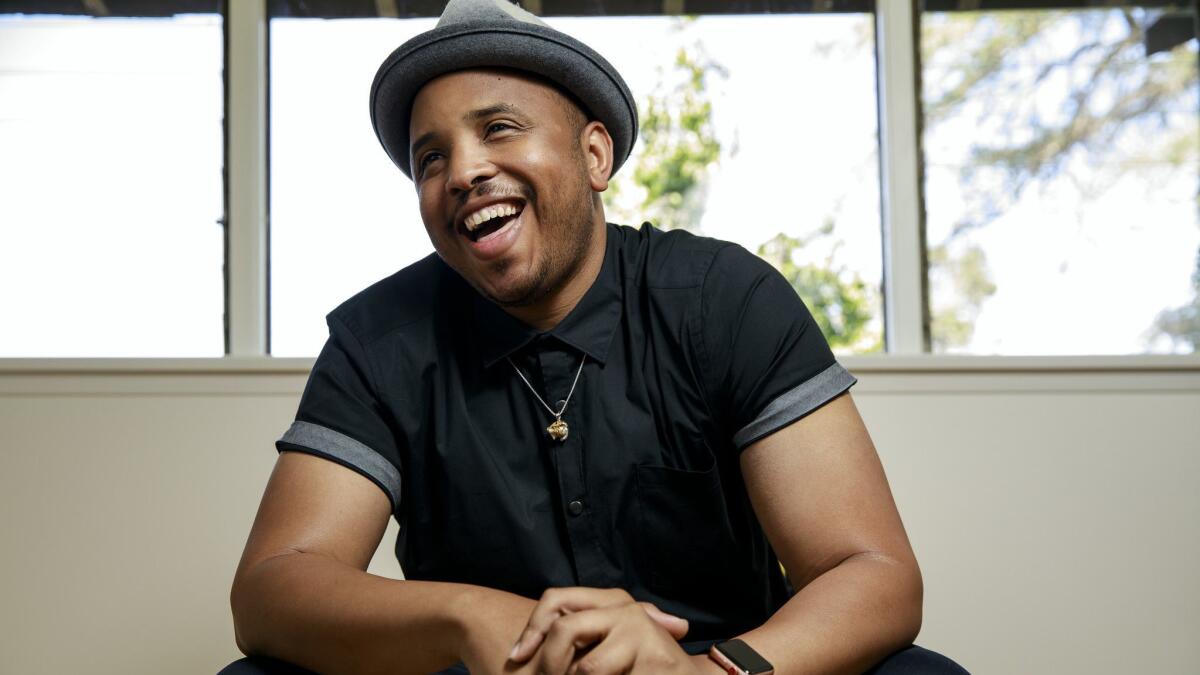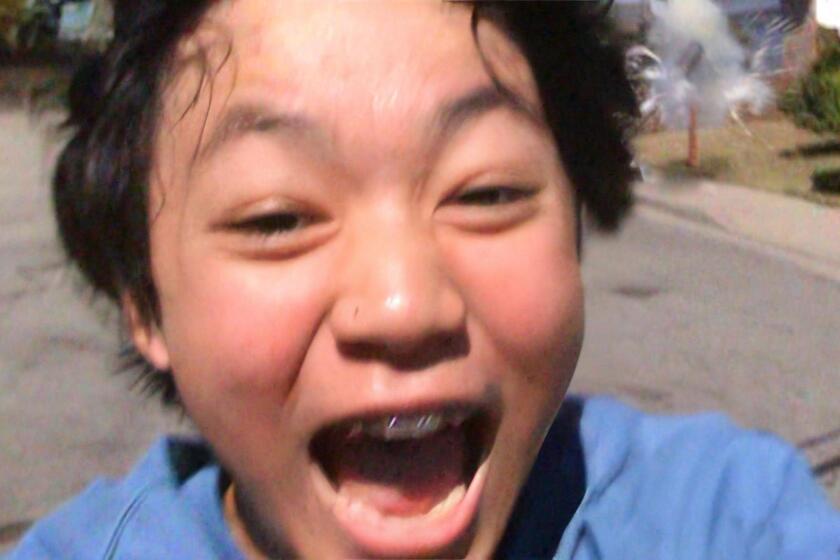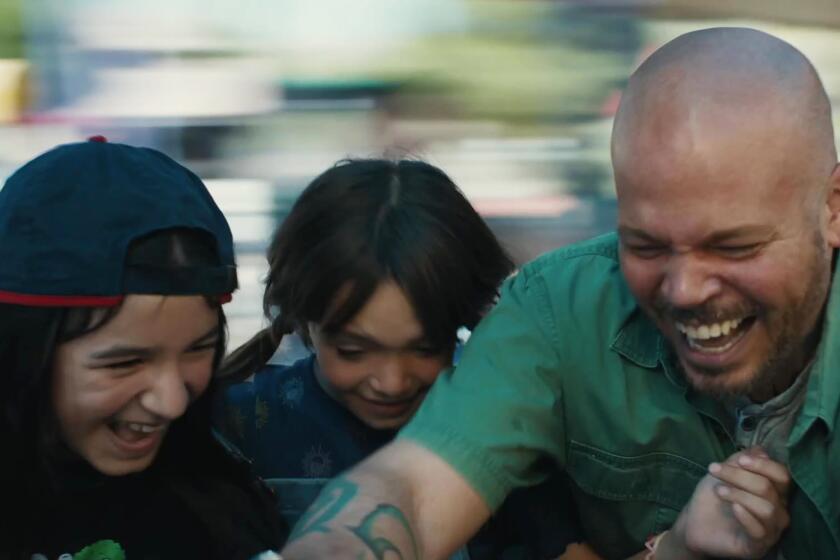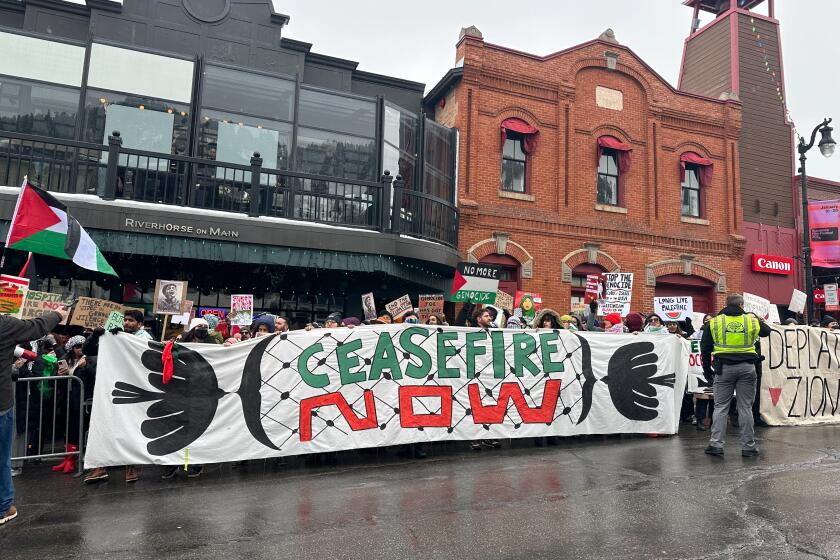Horror has deep roots in Justin Simien’s ’80s-set killer weave movie ‘Bad Hair’
Three years ago as “Dear White People” creator Justin Simien was developing his next film, Jordan Peele’s “Get Out” kicked open the door for the kind of story Simien wanted to tell: a horror film with an African American lead and something vital to say about the black experience in America.
Now “Bad Hair,” about a woman battling her own killer weave and other insidious forces, is opening the Sundance Film Festival, where “Get Out” debuted on its way to a $255-million global box office and a screenplay Oscar.
“I thought, ‘OK. People are ready for a black psychological thriller-horror movie,’” said Simien, who had successfully adapted his Sundance Special Jury Award-winning debut feature, “Dear White People,” into a Netflix series but struggled to make industry gains as a feature director.
He secured financing for “Bad Hair” and shot it on film, crafting an L.A.-set period horror with a young black professional protagonist seldom seen in Hollywood. With nods to 1960s and 1970s genre classics like “Invasion of the Body Snatchers” and “Rosemary’s Baby,” it combines scares, humor, social satire and ambitious themes into textured terrors and asks: What would you do if your hair had a mind of its own ... and a thirst for human blood?
That’s the crisis facing Anna Bludso, played by Elle Lorraine in a breakout role, an aspiring VJ in 1989 Los Angeles who trades her natural hair for a trendy new weave in order to move up the ranks at the MTV-styled network where she works.
“It felt like with black hair in particular it was such an American story,” said Simien, whose “Bad Hair” opens the Sundance Film Festival’s Midnight section on Thursday night with an original blend of corporate intrigue, new jack swing-era bops and hair, so much hair.
Anna’s journey spans the subgenres of body horror, psychological horror, creature horror and beyond as her weave leaves an existential trail of carnage in its wake.
“She’s in a vulnerable place in her life where she has to decide whether she has to sacrifice these little bits of herself along the way,” said Lorraine, who makes her starring debut in “Bad Hair.” “She doesn’t realize how far she may have gotten from herself.”
Filmed on location in Los Angeles on Super 16-millimeter using impressively tactile practical effects, Simien’s genre-blender is a wild ride with an ensemble that includes Vanessa Williams, Kelly Rowland, Jay Pharoah, Lena Waithe, Blair Underwood, Laverne Cox, Judith Scott, James Van Der Beek, Michelle Hurd, MC Lyte and Usher.
She’s in a vulnerable place in her life where she has to decide whether she has to sacrifice these little bits of herself along the way.
— Elle Lorraine on her “Bad Hair” heroine, Anna
Simien drew from assorted obsessions and influences including the 2005 Korean horror movie “The Wig” and Sion Sono’s 2007 horror film “Exte (Hair Extensions)” to write a twisted tale in which protagonist Anna discovers that, at least at first, her new weave brings the career success and attention she craves.
After getting her coveted coif at a mysterious salon, she lands the promotion of her dreams at RMV, the music video channel geared toward black audiences where the show she works on, “Culture,” has been renamed “Cult” by a new, white executive. But like those larger societal forces, her hair also has a sinister hunger that must be fed.
Two days before heading to Sundance, where “Dear White People” launched his career, Simien took a break in his office in the Sun Valley studio that’s home to the spinoff series he writes, directs and executive produces.
The thrill of making “Bad Hair” across Los Angeles, filming with cinematographer Topher Osborn and working with puppeteers on in-camera effects fed his inner cinephile, Simien said. And even with an outrageous premise that feels ripe for broad comedy, the approach helped keep the film’s tone down to earth.
“The premise was so crazy I felt I should ground it in a reality you believed as much as possible,” he said. “We had puppeteers who experimented endlessly with weaves, stop motion and reverse-photography to get the hair to do things like braid itself or climb up an arm … [it] was all part of the strategy of grounding the film so when it starts to go off into these crazy places, you go with it.”
Down the hallway, his “Dear White People” writers worked away on an episode for the show’s fourth and final season. Across the building stood stages where the fictional Winchester University comes to life when the show is filming.

In his office, a framed poster of Rowland in character as Sandra, the glamorous pop star whom Anna idolizes in “Bad Hair,” gazed fiercely out at the world. He glanced at it as he described how the pivotal year of 1989 in culture made for the perfect setting for the cautionary horror-satire.
“I was obsessed with that time period because that was the era when new jack swing broke through to the mainstream,” said Simien, who tapped into his own musical talents to write original songs for Rowland’s Sandra, whose fictional ascent was modeled after Janet Jackson, and consulted with Teddy Riley, one of the forefathers of new jack swing.
“It was like a Trojan horse,” he said. “It brought urban black culture into the mainstream. And it was eventually appropriated, as all things are, by white people. I thought that was an interesting backdrop to tell this story because that [mainstream success] is what Anna is trying to get. We’re inundated with commercials and messaging, everything in society telling us that we need to make it to that mainstream.”
Simien thought of the cultural messaging broadcast to generations of young African American women in particular. He wanted to weave the legacy of internalized beauty standards into “Bad Hair” along with elements of African American folklore and his own observations about the costs of success in America.
“I was angry with what I saw happening with black women,” Simien said. “Black women are the source for so much culture, from language to fashion to music, but are never allowed along for the ride. They are physically discarded by this society, by black men, by all men, by women of other races. I was mad about that and I wanted to say something about that.”
But first, he felt he needed more perspective. He called fellow filmmakers Waithe, Tiffany Johnson and Dime Davis, “the smartest black women I knew personally,” said Simien, “because the center of this movie was going to be a black woman. I feel like I understand it, and I’m angry about it. But I don’t want to be a gay black man writing what I think a woman’s story is.”
Black women are the source for so much culture, from language to fashion to music, but are never allowed along for the ride... I was mad about that and I wanted to say something about that.
— Justin Simien
They spent a long weekend in Palm Springs watching films for inspiration and sharing insights that Simien worked into his film, in which every character in the cast — from Williams’ fashion queen turned media mogul to Waithe’s straight-shooting VJ — brings a different dimension to larger themes of ambition and assimilation in a system that wasn’t built for, or by, people like them.
What it comes down to, says Simien, is that some people simply have fewer choices. “It’s not so much about whether or not it’s OK to get a weave, or to present yourself one way or the other,” he said. “It’s about the fact that you feel like in order to survive, in order to make something of yourself, you have these choices — and they both have really messed-up consequences.”
Having ambitions while also being a marginalized person can feel even more claustrophobic an existence, he said. “You often feel like you are being stuffed into a person-shaped corset. It’s a curated version of yourself that you have to walk around in, and it’s a walking death.”
These ideas resonated with the “Bad Hair” cast, some of whom have held Sandra-like positions of cultural influence in their own careers. Lorraine, who shares Houston roots with longtime friend Simien, even had Rowland’s poster on her walls growing up. But she felt Anna’s story even more intimately as an actress, musician and producer also seeking to carve out her own space in an industry obsessed with image.
“There are so many parallels between her experience and my personal experience,” Lorraine said. “Being a brown-skinned woman, to me she’s somebody who’s incredibly ambitious and deserves to have a seat at the table but is constantly judged on elements outside of herself.”
One scene she found hard to watch is when Anna, still battling a childhood trauma over a hair treatment chemical burn that left her scarred, is so desperate to change her look that she submits to an excruciating weave procedure, which Simien films with a visceral, skin-crawling flourish.
“I feel that pain and I’m confronted with the times in which I put myself through that experience,” Lorraine said. “To go as far as we sometimes go just to be considered beautiful. ... Watching it up close and being confronted by the symbolism [was] a deeper kind of pain.”
As a filmmaker, Simien acutely feels the choices available to him in an industry still largely closed off to underrepresented voices: how Hollywood sees and packages him on paper, the regret of the stories within him he may never get the opportunities to tell.
“I’ve gotten to do things that really do come from me and speak to my heart and get me up in the morning,” he said. “But it is also just a plain fact that my market value is not as high as my white counterparts. I go to a pitch meeting and I kill it, but on paper I’m a ‘black comedy director,’ therefore my name is not on that list.
“The horror of the movie, the thing that actually scares me personally about the movie, is that in order to move up the ladder of America, of success, I have to make these choices,” Simien said. “I have to cut off parts of myself that I actually might need in order to live my life, and to enjoy my life, and to be free in my life.”
But there are even more personal parts of his story he made sure to include in “Bad Hair,” a film dedicated to his mother, Anna, and her sisters Virgie, Edna and Zora, women he credits with raising him and supporting his artistic dreams, whom he named pivotal characters after.
“My mother is the youngest of nine, and my Aunt Virgie died between the second and third season of the show,” he explained, overcome with emotion. “And I just felt like I had to pay tribute to their names, because their names are not in the culture, but these are names that were very important to me.”
As for what happens after Sundance, Simien is a pragmatist who knows the realities and challenges facing independent films seeking distribution. For now, at least, he wants to start a conversation. “I’d love to be in theaters, but I would like it to hit the culture,” he said. “I want people to see it. I want them to know it happened. I want people to watch it together, no matter where it lands.”
More to Read
Only good movies
Get the Indie Focus newsletter, Mark Olsen's weekly guide to the world of cinema.
You may occasionally receive promotional content from the Los Angeles Times.












